Submachine gun MAT-49 (France)
Recall, shortly after the end of the war, the French army, in need of small arms, initiated the resumption of production of MAS-38 submachine guns. This weapon was created in the late thirties and had certain drawbacks, but in the current situation it was not necessary to choose. The mass production of the old product made it possible to partially close the needs of the army, but this did not eliminate the need to create new projects. The relevant work started in the near future.
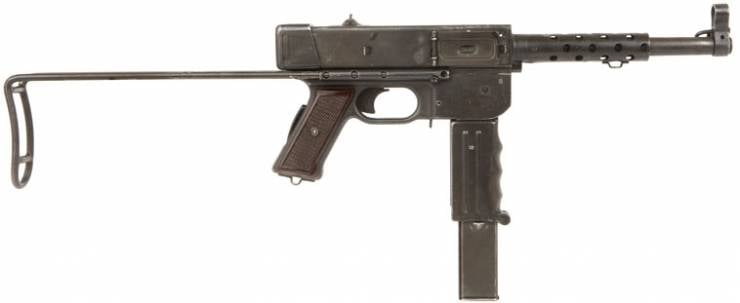
Submachine gun MAT-49. Photo Deactivated-guns.co.uk
All the leading French enterprises were involved in the program for creating a promising submachine gun. In accordance with the requirements of the military, the designers had to create a relatively light and compact weapon for a pistol cartridge with the possibility of automatic fire. Taking into account the operating experience of existing systems, the customer refused the cartridge 7,65x20 mm Longue, instead of which the more common 9x19 mm Parabellum should be applied. As in several previous versions of the technical specifications, there was a requirement for a folding weapon design, designed to facilitate transport.
Several enterprises participated in the program, including the Manufacture Nationale d'Armes de Tulle (MAT) plant from Tule. Its specialists already had some experience in creating weapons for the army and could use it when designing the next sample. The main designer of the new submachine gun from the company MAT became Pierre Montey.
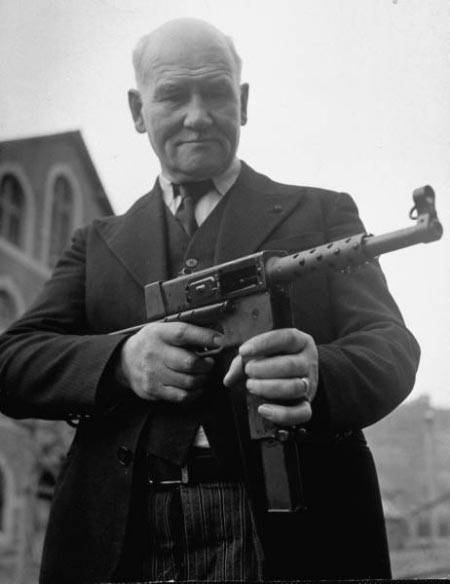
MAT-49 and its creator Pierre Montey. Photo Guns.com
The first prototype of the advanced weapon was assembled in the 1948 year, as a result of which it received the working designation MAT-48. Serial production was launched a year later, which was reflected in the name of the final version of the submachine gun - MAT-49. A few years later there was a modification of weapons, intended for the use of gendarmerie. Its name also reflected the year of appearance - MAT-49 / 54.
The project of the plant MAT proposed the use of their own and others' developments, as well as the experience gained during the years of the last war. This led to the abandonment of certain devices and solutions characteristic of pre-war weapons, but at the same time allowed us to obtain the desired characteristics and capabilities. In addition, some already well-known ideas were developed, which gave certain advantages over existing samples.
The project MAT-48 / 49 provided for the assembly of automatic weapons under the pistol cartridge, built according to the traditional scheme. The submachine gun had to be equipped with a medium-length barrel with a protective casing. Details of automation were in the receiver of a simplified rectangular shape, under which were placed the folding magazine receiver and the pistol grip. Instead of a wooden butt, typical of previous projects, it was proposed to use a simple metal part. It was proposed to manufacture all the main parts of the weapon by stamping, which seriously reduced the cost and labor intensity of production.
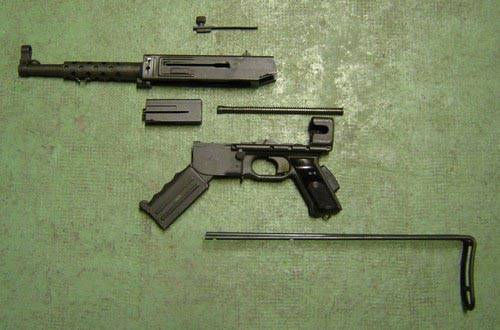
Incomplete disassembly of weapons. Photo Guns.com
Submachine gun MAT-49 was completed with a rifled barrel caliber 9 mm. The barrel had a length of 230 mm or 25,5 caliber. The outer surface of the barrel was cylindrical. Near the barrel on the trunk was placed a rack with a front sight. About two-thirds of the trunk was covered with a cylindrical casing. For better cooling of the barrel with atmospheric air, there were numerous round holes in the casing.
The project used the receiver a little unusual design. The bolt and return spring were supposed to be inside a square casing made in the form of a tube open at the back. The front end of such a casing had attachments for the trunk, the rear one was closed with a removable cover. Other submachine guns of that time were often completed with a tubular receiver of round section, but P. Montey and his colleagues decided to use a square piece.
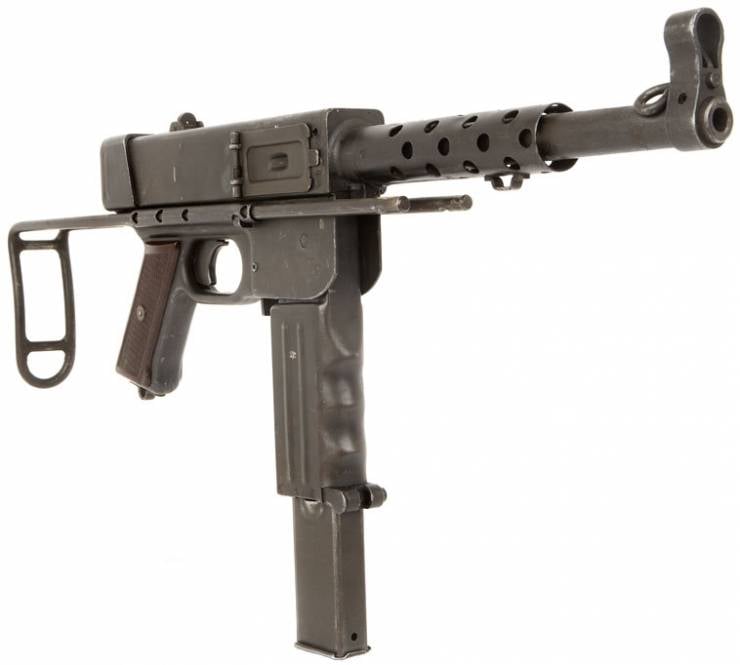
Submachine gun in a combat position. Photo Deactivated-guns.co.uk
On the right side of the receiver there was a large window for ejection of spent cartridges. In the transport position of the weapon, this window was closed with a rectangular lid. When the slide was moved backwards, the lid was folded back on the hinge with its own spring. In the left wall of the box provided a longitudinal groove for the bolt handle. From the bottom, in a rectangular tube, there were windows and slots for feeding cartridges, pulling out the details of the trigger mechanism, etc.
From the bottom, a relatively high part of a smaller width was attached to the tubular casing of the bolt, in front of which there was a receiving shaft of the store. Behind her, there was an integrated trigger bracket, and behind her, the metal base of a pistol grip.
Weapons used the principle of free shutter, which simplified the design of its internal devices. The shutter was made in the form of a massive rectangular block with several slots and channels for connecting with other parts. Behind the bolt backed back-fighting spring. Cocking mechanisms carried out with the help of the handle, derived on the left side of the weapon. The handle was rigidly connected to the plate-curtain, covering the longitudinal groove of the receiver. When firing, the handle remained in the forward position and did not move with the shutter.
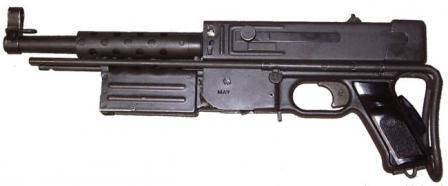
MAT-49 with the store receiver folded; the store itself is missing. Photo Modernfirearms.net
The shot was carried out with an open shutter, and therefore the weapon did not need a complex trigger mechanism. All the main parts of the latter were placed inside the pistol grip. Fire control was carried out by a trigger of a traditional design. Initially, the MAT-49 product could only fire in single bursts without the possibility of fire. Safe handling of weapons provided automatic fuse. His large key was on the back of the pistol grip. To unlock the trigger and shooting the key should be pressed all the way into the handle.
The use of a folding butt did not allow for a drastic reduction in size in the transport position, and therefore, in the thirties, folding receivers were used in new French projects. The new project MAT-48 / 49 also provided for the use of such devices.
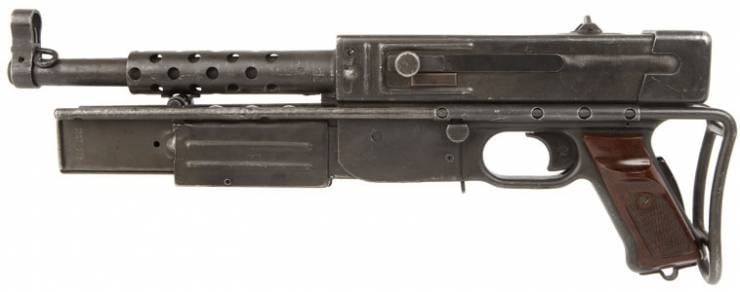
Folded weapons with a magazine. Photo Deactivated-guns.co.uk
The receiving shaft, which was part of the receiver, had a U-shaped form in plan and was not equipped with a front wall. Inside it, on two semi-axes, was placed a rectangular store receiver. The receiver received the front edge of a complex "anatomical" shape. In the vertical combat position, he served as the second handle. At the rear of the box shaft there was a latch locking the receiver in the working position. The latch holding the magazine was placed in front.
When transferring the weapon to the transport position, it was necessary to press the back latch and turn the receiver with the magazine forward. After that, he held a horizontal position under the barrel. Fixation was carried out by the latch on the front wall of the receiver and the hinge under the barrel cover. Before the battle, weapons were returned to the working position.
Two magazines were developed for the MAT-49 submachine gun. Both products had a box-shaped case of the same dimensions with different internal equipment. The first version of the store contained 32 cartridge, arranged in two rows. The second product was distinguished by the single row arrangement of 20 cartridges. A simpler single-row shop was more resistant to pollution and therefore was intended for use in the difficult conditions of the North African deserts.
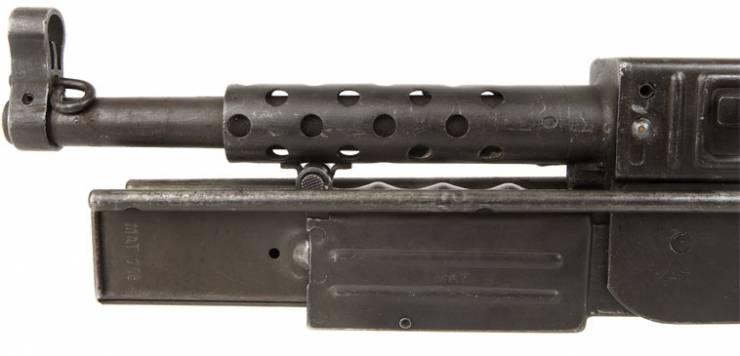
Barrel casing and shop. You can consider the receiver lock. Photo Deactivated-guns.co.uk
The submachine gun was equipped with simple sights. On the muzzle of the trunk was placed support with a front sight mounted inside the protective ring. On the receiver, near its back cover, there was an open sight with a flip entirely. The latter could be used for aimed fire at a distance of 50 or 100 m.
The weapon was equipped with a butt of the simplest design, which should be made of several metal rods. The base of the butt was a pair of parallel horizontal barriers, smoothly turning into a curved shoulder rest. The latter had a pair of small transverse elements. The front bars of the butt entered the tube mounted on the sides of the receiver. In the unfolded position, the butt was fixed with an uncomplicated latch.
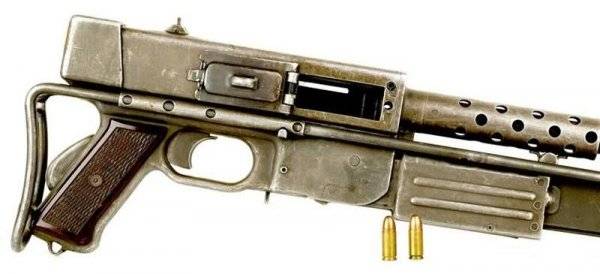
Folded submachine gun, right side view. Photo Armoury-online.ru
Submachine gun MAT-48 / 49 had the simplest accessories, providing an acceptable convenience of the shooter. Metal or plastic handles were fixed on the metal base that held the USM parts. On the back of its surface protruded key fuse. The second hand of the shooter had to hold the weapon by the metal receiver of the store of the optimized form.
The MAT-49 had a total length (with the butt extended) 660 mm. Folded stock reduced this parameter to 404 mm. The foldable design of the magazine receiver allowed to dramatically reduce the vertical size of the weapon, after which it was determined only by a rigidly fixed pistol grip. In the transport position, the submachine gun had a height of no more than 150 mm with a width of less than 50 mm. Weapons without a magazine weighed 3,6 kg.
Automatics based on the free gate, using the Parabellum mm 9x19 cartridge, showed a rate of fire at the level of 600 rounds per minute. The effective firing range reached 150-200 m. In this parameter, the new submachine gun was superior to previous products in its class, using a less powerful cartridge.
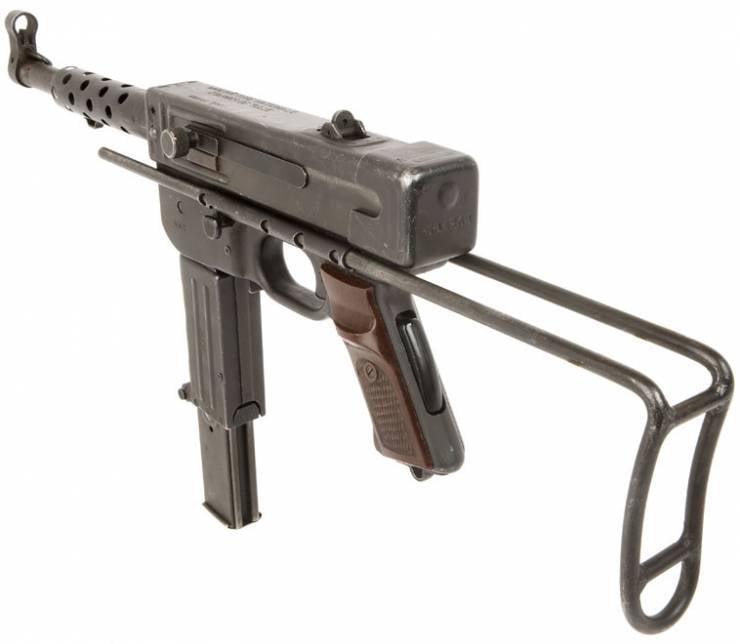
Butt close up. Photo Deactivated-guns.co.uk
At the end of the forties, several samples of perspective small arms of the French design passed the necessary tests, and some of them managed to get a recommendation for adoption. MAT-48 from the Manufacture Nationale d'Armes de Tulle was recognized as one of the most successful samples. Soon the latter received an order for full-scale mass production of new weapons. The submachine gun was adopted in the 1949 year, which was reflected in its official designation.
Serial weapons were supplied to various units of the French army and gradually filled their arsenals. Over time, the production of submachine guns MAT-49 allowed to reduce the proportion of obsolete samples, and then abandon them. By the end of the fifties, the plant of Thule and other enterprises involved in the production of weapons completed the rearmament of the army. According to reports, during the serial production of a submachine gun for the army did not undergo major changes. The only exception was small-scale products that had a barrel with a thread for installing a silent-firing device.
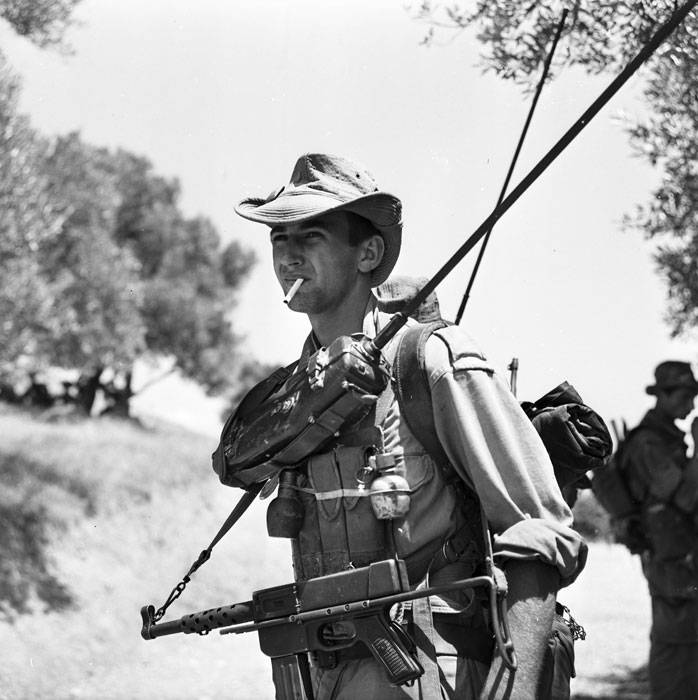
French soldier with submachine gun MAT-49. Photo Sassik.livejournal.com
In the early fifties, the National Gendarmerie of France became interested in new weapons. Soon, according to her order, a specialized version of the submachine gun was created. The product MAT-49 / 54, put into service in the 1954 year, differed from the basic modification of a wooden butt, an elongated barrel, fully enclosed casing, and a modified trigger mechanism. As part of the latter there were two triggers: one was responsible for shooting single, the second - for automatic fire. The rest of the MAT-49 / 54 repeated the design of the base sample.
From a certain time, the submachine guns MAT-49 were produced not only for domestic customers. A simple, effective and inexpensive weapon interested the military and law enforcement officers from third countries. Subsequently, a significant number of orders for the supply of arms to three dozen armies of Asia and Africa appeared. Due to the specific military-political situation in these regions, French submachine guns often “entered service” by various armed formations and were used against former owners.
Of particular interest are the submachine guns MAT-49, which in the recent past were in service with Vietnam. In the middle of the 20th century, France tried to keep its colonies in Southeast Asia under control, which led to the beginning of the war. French weapons often became the trophy of the Vietnamese, and they used it in subsequent battles. From a certain time, the Vietnamese army workshops began to remake French submachine guns and install new barrels on them. For logistical reasons, this weapon was transferred to the Soviet cartridge 7,62x25 mm TT. Such samples were actively used during all subsequent conflicts, up to the final liberation of Vietnam.
Serial production of submachine guns MAT-49 continued in France until the end of the seventies and was minimized due to the advent of the new weapon. Soon the process of replacing outdated systems with new ones began. Place MAT-49 in the army took the latest automatic rifle FAMAS. Within a few years, the machine guns no longer needed were sent to storage; some of them were subsequently disposed of as unnecessary.
The operation of the MAT-49 products in other countries lasted longer. Not having access to newer weapons, the poor states of Africa and Asia were forced to retain existing submachine guns. At the same time, by now many of these countries have been able to find opportunities for updating their arsenals. However, according to various sources, the French post-war MAT-49 is still used by some armies and law enforcement agencies.
After the end of World War II, France launched a major rearmament program, one of the elements of which was to produce promising submachine guns. The product MAT-48 / 49 was supposed to replace outdated weapons of pre-war development and bring the combat performance of the troops to the required level. This task was successfully solved, and the army received a new weapon. In addition, a successful project allowed the French industry to take a favorable position in the international market of small arms.
Based on:
http://modernfirearms.net/
http://guns.com/
https://militaryfactory.com/
Popenker MR, Milchev M.N. World War II: gunsmiths war. - M .: Yauza, Eksmo, 2008.
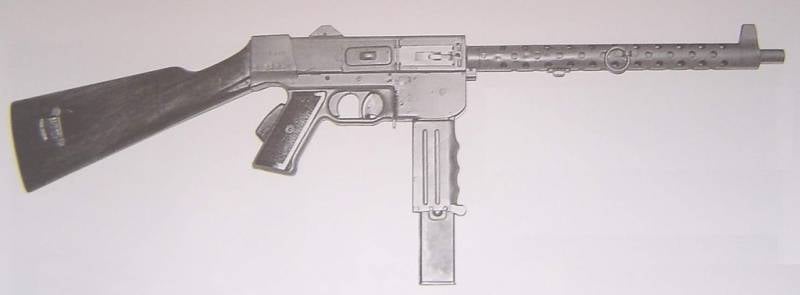
Information